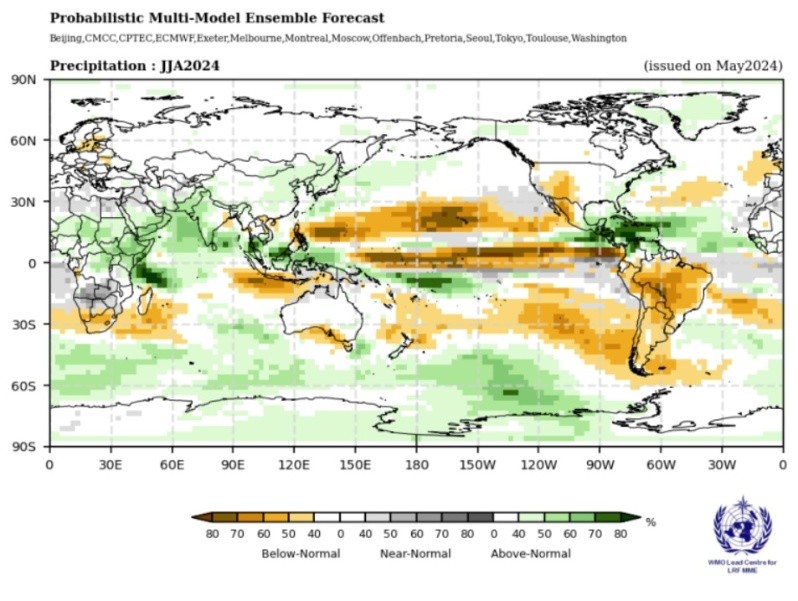the drought That affected Argentina in 2023 could hit the region again in 2024 and 2025 if the climate forecasts of the World Meteorological Organization (WMO) are met, the organization that predicted on Monday that the phenomenon known as “The El Niño phenomenon will end in the middle of this year It won't happen again for the next few months. In that context, The chances of a repeat of “La Nina” at the end of 2024 are increasingIt is an impact that affected South America from 2020 to 2023.
The World Meteorological Organization notes in its latest report that “the 2023/2024 El Niño phenomenon, which helped raise global temperatures and extreme weather around the world, is showing signs of ending. A return to El Niño conditions is likely later this year.” . On these two global climate phenomena, which have almost opposite effects.
The World Meteorological Organization forecasts state that between June and August 2024, there is a 50% chance that the El Niño phase will transition to “neutral conditions” and a 50% chance that it will turn into a La Niña phenomenon.
while, There is a 60% chance of La Niña occurring from July to September and a 70% chance from August to November.According to the World Meteorological Organization, which considers that “the risk of the El Niño phenomenon reappearing again is negligible during this period.”
According to the agency, the chances of the El Niño phenomenon developing again during the remainder of the year are “slim.” The date of the potential return of drought is key because it may coincide with the start of wheat, corn and soybean planting for the 2025 campaign, i.e. a new dry season could mean a potential reduction in harvest and the consequent liquidation of foreign exchange from next year's planting.
La Niña refers to a large-scale cooling of ocean surface temperatures in the central and eastern equatorial Pacific, a phenomenon associated with changes in tropical atmospheric circulation.
the The exact effects vary depending on their severity and duration, as well as the time of year in which the phenomenon occurs and the interaction with other climate phenomena.The United Nations says. The regional factor must also be taken into account when talking about these effects, as the La Niña phenomenon in tropical regions produces climate effects opposite to those caused by the El Niño phenomenon.
The date of the possible return of the drought phenomenon is considered crucial, because it may coincide with the beginning of the planting of wheat, corn and soybeans for the 2025 campaign, that is, a new drought may lead to a decrease in yields and yields and a consequent decrease in the liquidation of foreign exchange from the agricultural sector next year.
How does La Niña affect climate?
El Niño, also known as the Southern Oscillation (ENSO), and La Niña are two aspects of the same natural phenomenon: Temperature change in the tropical Pacific OceanEspecially in its central and eastern regions. This phenomenon affects climatic conditions in various parts of the world, especially South America and Argentina. It includes three phases: El Niño, La Niña, and a neutral phase.
The effects of this fluctuation in Argentina vary depending on the region, time of year and final stage. For example, during El Niño, spring and summer are usually the rainiest in our country and can lead to floods. On the same dates, Rainfall is usually lower than normal in La Niña, and it can cause droughts like the one recorded between 2022 and 2023.

This phenomenon has an irregular periodicity and usually occurs every two to seven years. According to the National Weather Service, an El Niño or La Niña phase is declared when sea temperatures in the eastern tropical Pacific Ocean rise or fall by 0.5°C above or below average for several consecutive months (5 quarters).
The World Meteorological Organization warned that these natural climate phenomena “are now occurring in the context of… Human-induced climate changewhich increases global temperatures, exacerbates extreme weather and climate conditions, and affects monsoon rainfall and temperature regimes.”
In this sense, they pointed out that the past nine years were the warmest on record even considering the effects of the La Niña phenomenon that lasted from 2020 to early 2023. As for the El Niño phenomenon, it reached its peak in December 2023 and has established itself as one of the warmest years. In the world. One of the five strongest ever.


:quality(85)/cloudfront-us-east-1.images.arcpublishing.com/infobae/TTMX4RVB62WDAXL4WZ2WRAVRSE.jpg)
:quality(85)/cloudfront-us-east-1.images.arcpublishing.com/infobae/OVPEHD3JLVENTCHIRGQMS6DMJY.jpg)

